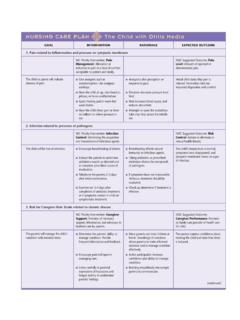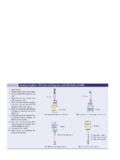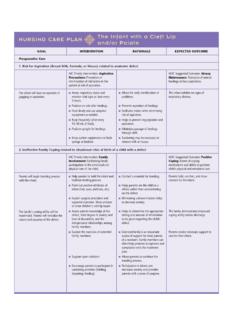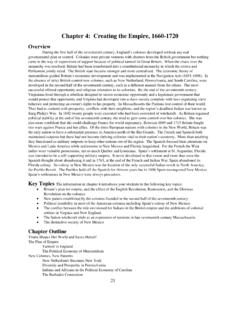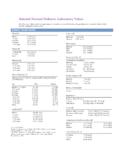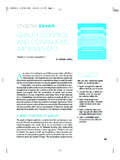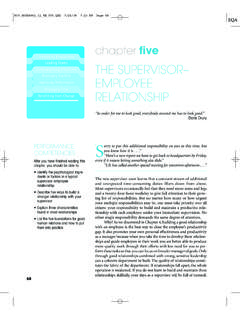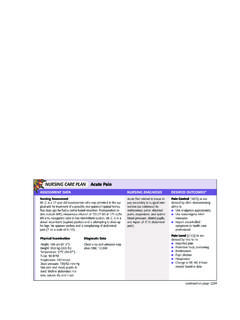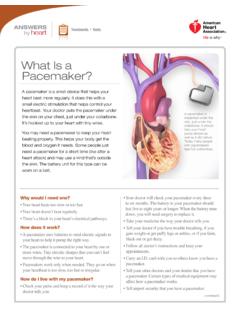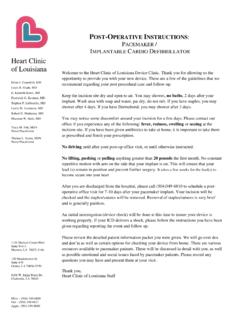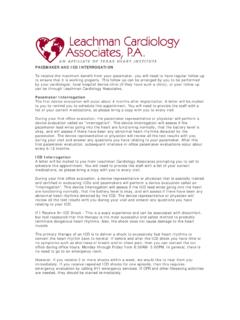Transcription of NURSING CARE OF THE CLIENT HAVING A …
1 860 UNIT VIII / Responses to Altered Cardiac Function NURSING care OF THE CLIENT HAVING A PERMANENT PACEMAKER IMPLANT. PREOPERATIVE care may cause myocardial irritability and dysrhythmias. Fibrotic tis- Provide routine preoperative care and teaching as outlined in sue develops within 2 to 3 days. Chapter 7. Document the date of pacemaker insertion, the model and Assess knowledge and understanding of the procedure, clari- type, and settings. This information is important for future refer- fying and expanding on existing knowledge as needed. ence. Clarifying knowledge, providing information, and conveying Immediately report signs of potential complications, including emotional support reduces anxiety and fear and allows the CLIENT myocardial perforation, cardiac tamponade, pneumothorax or to develop a realistic outlook regarding pacer therapy.
2 Hemothorax, emboli, skin breakdown, bleeding, infection, en- Place ECG monitor electrodes away from potential incision docarditis, or poor wound healing (see Chapter 30 for more in- sites. This helps preserve skin integrity. formation about cardiac tamponade and endocarditis, and Teach range-of-motion (ROM) exercises for the affected side. Chapter 36 for pneumothorax and hemothorax ). Early identifi- ROM exercises of the affected arm and shoulder prevent stiffness cation of complications allows for aggressive intervention. and impaired function following pacemaker insertion. Provide a pacemaker identification card including the manu- facturer's name, model number, mode of operation, rate pa- POSTOPERATIVE care rameters, and expected battery life.
3 This card provides a refer- Provide postoperative monitoring, analgesia, and care as out- ence for the CLIENT and future health care providers. lined in Chapter 7. Obtain a chest X-ray as ordered. A postoperative chest X-ray is HOME care . used to identify lead location and detect possible complications, Provide appropriate teaching for the CLIENT and family about: such as pneumothorax or pleural effusion. Placement of the pacemaker generator and leads in relation to Position for comfort. Minimize movement of the affected arm the heart. and shoulder during the initial postoperative period. How the pacemaker works and the rate at which it is set.
4 Restricting movement minimizes discomfort on the operative Battery replacement. Most pacemaker batteries last 6 to 12. side and allows the leads to become anchored, reducing the risk years. Replacement requires a outpatient surgery to open the of dislodging. subcutaneous pocket and replace the battery. Assist with gentle ROM exercises at least three times daily, be- How to take and record the pulse rate. Instruct to assess pulse ginning 24 hours after pacemaker implantation. ROM exercises daily before arising and notify the physician if 5 or more BPM. help restore normal shoulder movement and prevent contrac- slower than the preset pacemaker rate.
5 Tures on the affected side. Incision care and signs of infection. Bruising may be present Monitor pacemaker function with cardiac monitoring or inter- following surgery. mittent ECGs. Report pacemaker problems to the physician: Signs of pacemaker malfunction to report, including dizziness, Failure to pace. This may indicate battery depletion, damage fainting, fatigue, weakness, chest pain, or palpitations. or dislodgement of pacer wires, or inappropriate sensing. Activity restrictions as usually is limited to contact Failure to capture (the pacemaker stimulus is not followed sports (which may damage the generator) and avoiding heavy by ventricular depolarization).
6 The electrical output of the lifting for 2 months after surgery. pacemaker may not be adequate, or the lead may be dis- Resume sexual activity as recommended by the physician. lodged. Avoid positions that cause pressure on the site. Improper sensing (the pacemaker is firing or not firing, re- Avoid tight-fitting clothing over the pacemaker site to reduce gardless of the intrinsic rate). This increases the risk for de- irritation and avoid skin breakdown. creased cardiac output and dysrhythmias. Carry the pacemaker identification card at all times, and wear a Runaway pacemaker (a pacemaker firing at a rapid rate).
7 MedicAlert bracelet or tag. This may by due to generator malfunction or problems with Notify all care providers of the pacemaker. sensing. Do not hold or use certain electrical devices over the pace- Hiccups. A lead positioned near the diaphragm can stimulate maker site, including household appliances or tools, garage it, causing hiccups. Hiccups may occur in extremely thin clients door openers, antitheft devices, or burglar alarms. Pacemakers or may indicate a medical emergency with perforation of the will set off airport security detectors; notify security officials of right ventricle by the pacing electrode tip.
8 Its presence. Assess for dysrhythmias and treat as indicated. Until the Maintain follow-up care with the physician as recommended. catheter is seated or adheres to the myocardium, its movement amplitude of peripheral pulses; color; presence of dyspnea, dysrhythmias may include Ineffective tissue perfusion, Activity adventitious lung sounds; ECG rhythm analysis; oxygen sat- intolerance, and Fear or Anxiety. uration levels Decreased Cardiac Output NURSING Diagnoses and Interventions Dysrhythmias can affect cardiac output. Bradycardias decrease The effect of the dysrhythmia on cardiac output is the priority cardiac output if the stroke volume does not increase to com- of NURSING care .
9 Other potential NURSING diagnoses related to pensate for the slow heart rate. Tachycardia reduces diastolic

